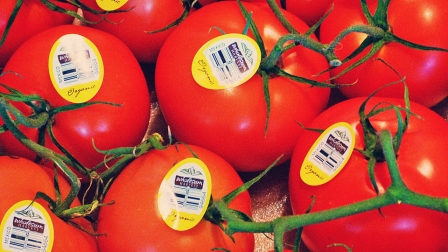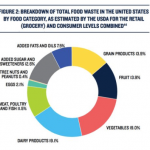The Epic Fight Over How To Label “Natural” Foods
Walk around a local farmers’ market or a big chain like Whole Foods or even Walmart and you’ll be overwhelmed by the sheer variety of “natural” and “healthy” foods. Consumers want foods they believe offer more health benefits and are made without artificial ingredients, and farmers and food manufacturers are happy to sell to them. But how can you trust that all those products are truly “natural” and “healthy”? It’s complicated.
The Food and Drug Administration (FDA), the government agency that oversees food labeling in the United States, is changing its definition of what “healthy” actually means—and are still trying to figure out a definition for “natural foods.”
The FDA recently ended a public comment period—a length of time during which the agency accepts letters from the public—when they took input on what their definition of “natural foods” should be. But different industry players have very different definitions of what natural and healthy actually mean; many consumers aren’t too sure either and it will take quite some time for the FDA to come up with its own answers.
In an email to Fast Company, press officer Lauren Kotwicki said that the FDA is currently reviewing hundreds of comments and “cannot speculate on how long this will take to review or what will happen next.”
One thing is for sure—the agency’s definition of those two terms will have an enormous financial impact, both on the food industry and on consumers’ grocery budgets.
Enter The Naturalplex
This past March, a cavernous convention center in Anaheim, California, was taken over by a unique trade show. The Natural Products Expo West bills itself as “the world’s largest natural products event,” and is indeed a big deal: More than 75,000 attendees crowded the Anaheim Convention Center to find out about foods, drinks, and vitamin supplements. Speakers such as former White House chef Sam Kass addressed the crowd, and buyers from America’s biggest supermarket chains and small health food stores alike hustled to make deals.
Attendees at Natural Products Expo West are at the center of a massively growing industry. Vendors hawked the virtue of multivitamins, organic breads, compassionately raised meats… and more newfangled innovations like boxed macaroni and cheese dinners and peanut butter cups. One of the more familiar brands, Annie’s Homegrown, which sells “natural” macaroni and cheese, is a reliable moneymaker for their parent company, the multinational General Mills.
Companies like Annie’s, the large supermarket chains they sell to, and the trade groups that represent both are increasingly formidable frenemies for the FDA. When the agency sought out public comment on the definition of natural foods, two trade groups, the Institute of Food Technologists and the International Dairy Foods Association, both requested an extension on the comment period. To give an idea of the dollar amounts at stake over the definition of “natural” on food labels, the International Dairy Foods Association represents an industry that makes approximately $125 billion yearly.
“Continuous Lawsuits”
Despite the size of the natural products industry, there’s a twist: A number of high-profile lawsuits have scared companies away from using the term “natural” in many cases.
Over the past decade, among others, both Whole Foods and Trader Joe’s were sued for labeling foods as “natural” when they contained ingredients such as sodium acid pyrophosphate (SAPP), a synthetic leavening agent, and the food thickener xanthan gum. Trader Joe’s settled out of court, while Whole Foods’ lawsuit is still making its way through court as of spring 2016. At press time, Quaker Oats faces a similar lawsuit.
Worries about litigation resulting from using the word “natural” in labeling have led many manufacturers and brands to avoid using the term.
Michael Joseph, the CEO of organic meal delivery service Green Chef, told Fast Company in a telephone interview that he saw what he calls “continuous lawsuits” in the food industry over the use of “natural” in food labeling.
His company, which competes in a brutal market vertical against competitors like Blue Apron Foods and HelloFresh, is exactly the kind of startup for whom labeling foods as “organic” or “healthy” can make or break their business.
Rather than using the term “natural,” Green Chef makes the choice to label their meals as organic—and, unlike “natural,” the FDA and USDA have very specific definitions of which foods can be labeled organic. Joseph says that his company has to adhere to a complicated compliance process for organic labeling, but that there’s nothing comparable for labeling foods as natural.
Joseph, who has a background in the organic food industry, added that “I didn’t use the word ‘natural’ a lot before—maybe in a blog post, for instance—but using it in commerce is something that I stayed away from because of the lack of context or meaning. […] Every business person selling a lot of organic food stays away from ‘natural’ because of the ambiguity.”
By contrast, Joseph added, there is a clear pathway to labeling foods as “organic” that gives customers a clear idea of how food is sourced and processed, and lets companies ensure they are adhering to federal guidelines.

Natural Money, Healthy Money
The FDA’s decision on the definitions of “healthy” and “natural” will impact how individual vendors label their foods, and what terms can be used in advertising. This is more than just an issue of semantics—it impacts the purchases of a large audience of customers who view the purchasing of organic foods as a marker of cultural identity.
These branding decisions can have a big impact on individual companies. Kind Snacks, a well-known manufacturer of snack bars, recently fought an expensive battle with the FDA to argue for the right to use the term “healthy” in their labels. The FDA argued that four of their bars exceeded the agency’s threshold to label a product as “healthy” because they have three grams of total fat and the one gram of saturated fat per serving.
Kind prevailed; months after the FDA sent the agency a warning letter, the agency reversed their stance and confirmed Kind could use “healthy” in their labels. At the same time, the FDA also announced they are readdressing their definition of the word “healthy” and accepting public comment on the definition.
In an email to Fast Company, the agency claimed that the FDA’s decision “was prompted in part by a citizen petition issued by Kind last December.”
Daniel Lubetzky, Kind’s CEO, told Fast Company that in contacting the FDA, his company relied on a team of operating and regulatory professionals that included both in-house staff and outside counsel.
Lubetzky added that “Our first action when we heard from the FDA was to achieve compliance and to make the requested changes to our packaging and web site, which included removing the term “healthy.” At the same time, we looked more closely at the regulatory definition of “healthy” and learned that the existing standard—which was introduced with the best intentions more than 20 years ago—needed to be updated to become consistent with current dietary guidelines and nutrition science.”
“We learned that the current regulation was introduced when the benefits of consuming “good fats,” like those in nuts, a key ingredient in many Kind snacks, were not fully understood. Under the regulation, foods like fat-free chocolate pudding and children’s sugary cereal can bear a healthy nutrient claim but foods like nuts and avocados can’t.”
And these sorts of labeling choices have big consequences. Last December, Consumer Reports’ National Research Center surveyed more than 1,000 American adults on their food shopping habits. More than 60% of respondents say they usually purchase foods labeled “natural,” but slightly less than two-thirds of them believe in a particular meaning of “natural foods”—foods that don’t contain genetically modified ingredients, hormones, pesticides, or artificial ingredients.
In fact, the definition of “natural” foods on labels currently allowed by the FDA means essentially whatever a manufacturer wants—there’s nothing stopping a food containing GMOs or made using artificial ingredients from being labeled as “natural.”
When I asked Kotwicki about the use of “natural” on labels, she told me that the FDA has traditionally considered the term “natural” to mean that no artificial or synthetic ingredients, including any color additives, were added to the food “that would not normally be expected to be in that food.” She then made sure that I understood “this policy was not intended to address food production methods, such as the use of pesticides, nor did it explicitly address food processing or manufacturing methods, such as thermal technologies, pasteurization, or irradiation.”
That, however, leaves room for many different interpretations of “natural.”
Shortly after publishing its survey, Consumer Reports called for the FDA to either ban the use of “natural” on food labels or that the FDA should create a verification process similar to that used for organic foods.
The Natural Industrial Complex
All of this is to say that natural foods are extremely big business. As multinationals like General Mills and large grocers like Kroger and Target find customers clamoring for natural and organic food, they adjust their trajectories according.
According to the Organic Trade Association, an industry group, organic foods alone generated $4.2 billion in sales in 2015. A large part of this demand was thanks to increased accessibility and larger market trends such as increased interest in gluten-free foods.
As part of its mandate, the FDA has to find a description for natural foods that satisfies the general public, consumer advocacy groups, food manufacturers and retailers, while all the while ensuring that description passes the common sense test.
It’s not easy, but sooner or later the stakeholders will have to figure out the solution. Meanwhile, the clock’s ticking for the FDA and other stakeholders to figure out what natural foods are exactly. Just a few weeks ago, the FDA updated rules on nutrition and supplement facts on labels, as well as serving sizes; a new law is also mandating the labeling of any food containing genetically modified material. Food science is changing faster than the government and corporations can keep track of, and the only clear losers are the public—who still don’t have a clear definition of what “natural foods” actually are.
Fast Company , Read Full Story
(38)













